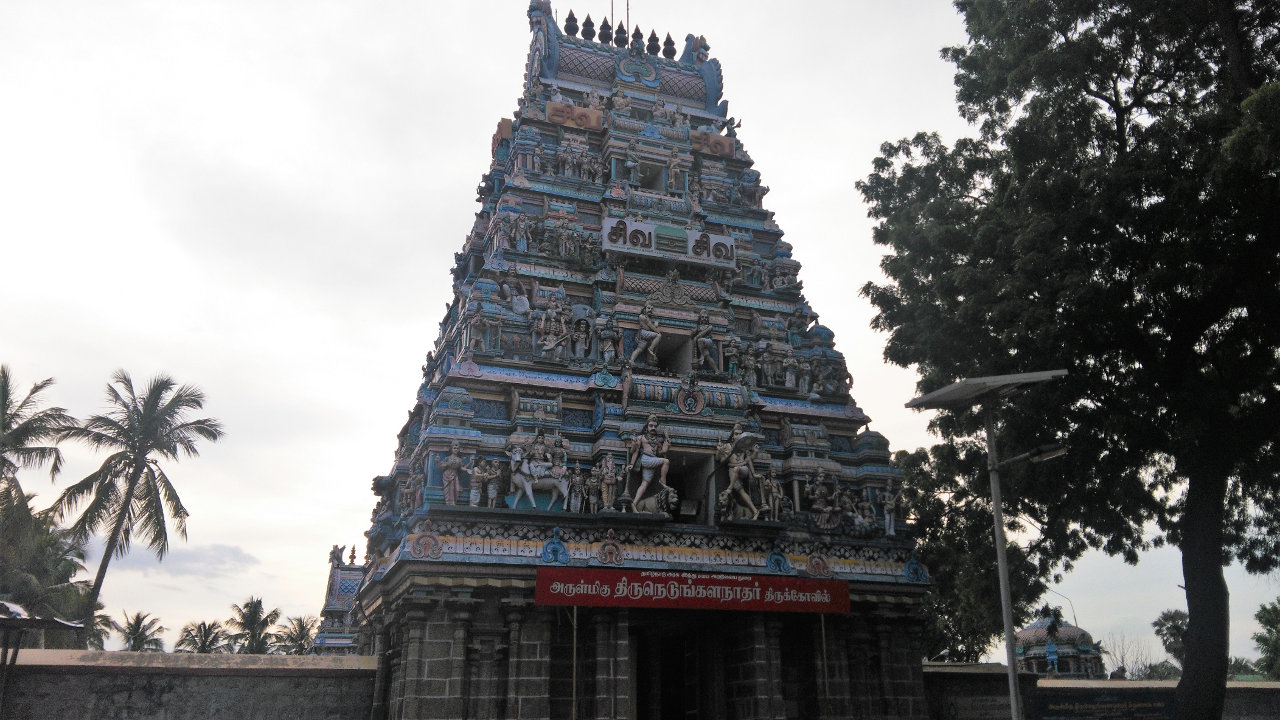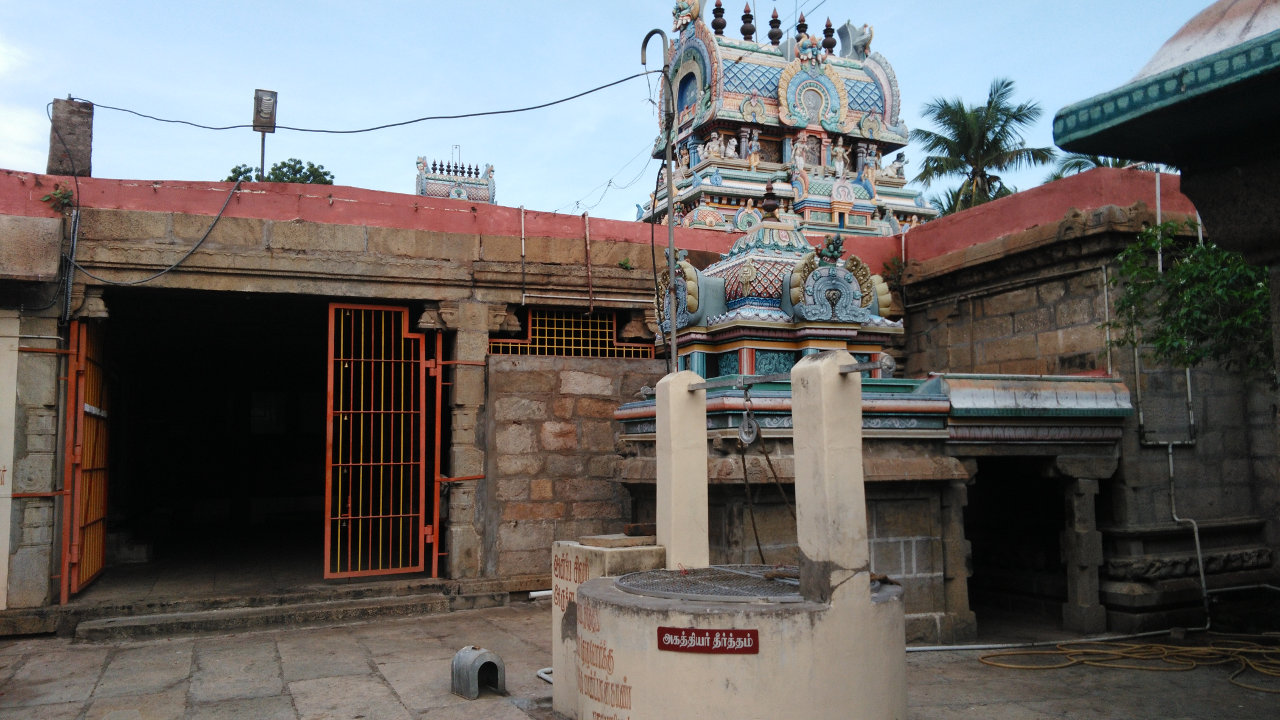Visited on: 30th September, 2017.
Location
Nedungalam is situated at a distance of about 4 kms from Thuvakkudi (near Thiruverumbur) on the Thiruchirappalli to Tanjure route. Thuuvakkudi is about 17 kms away from Thiruchirapalli and 42 kms away from Tanjure.
Other Devara Paadal Petra Shiva Sthalams near this place are – Thiru Erumbiyur (Thiruverumbur), Mukkeecharam (Urayur) and Thiruchirapalli (Malaikkottai).
General Information
| Moolavar | Sri Nedungalanathar, Sri Nithya Sundareswarar |
| Ambal | Sri Oppila Nayaki, Sri Mangala Nayaki |
| Theertham (Holy water) | Agasthiyar Theertham, Sundara theertham |
| Sthala Vriksham (Sacred Tree) | Vilvam & Kasthuri Arali |
| Pathigam (Hymn) rendered by | Saint Thirugnanasambanthar |
- This is one of the 276 Devara Paadal Petra Shiva Sthalams and 8th Shiva Sthalam on the Southern bank of the river Cauveri in Chozha Nadu (Thenkarai).
- Lord Shiva in this temple is a Swayambumurthi (self-manifested).
- This Sthalam is considered to be as sacred as Kasi.
- Saint Thirugnanasambanthar’s pathigam of this temple is very famous and is known as “Idar Kalaiyum Pthigam” (which can be loosely translated as “the Pathigam that removes obstacles”).
- This east facing temple has two corridors and its main tower (Rajagopuram) has 5-tiers.
- The last consecration ceremony (Maha Kumbabishekam) took place on 12.03.2014 and prior to that on 30.06.1999.
History of the Temple
Thiru Nedungalam in Tamil means vast plains. This place has been described as “Nedungala Maanagar” in Devaram. It means that it used to be a large city in the olden days. However, now it is a small village.
This place is also known as “Dakshina Kailash” (Southern Kailash).
There are certain stone inscriptions in this temple which date back to the periods of Chola kings Parakesari Varman, Rajarajan, Rajarajan-III, Kulothungan-III and Aditya Karikalan-II. A few other inscriptions date back to the periods of Pandiyas, Hoisala and Vijayanagaram kingdoms.
The lord here is praised by many names - Nedungalanatha Swamy, Nedungalathu Mahadevar, Nedungalathu Nayanar, Kalanthai Nayakar, Kayilayathu Mahadevar and Sundaramurthy.
This temple is under the administrative control of the Hindu Religious and Charitable Endowments Department of Government of Tamil Nadu (HR&CE).



Legend
Lord Shiva in this temple is depicted as Sri Arthanareeswarar. Arthanareeswarar signifies a synergy between Lord Shiva and Goddess Parvathy. According to the legend of this temple, Lord Shiva is not seated in the centre of the sanctum. He is seated a little bit away from the centre, making way for Goddess Parvathi to occupy a place near him. Although there is no idol for Goddess Parvathi inside the sanctum, she is believed to be present there (present as “Aroopam” or “formless”). Hence, there are two towers (Vimanams) on the sanctum sanctorum. Such a structure having two Vimanams can only be seen in Kasi.
It is believed that while Goddess Parvathi was performing penance in this place, Lord Shiva came in the form of a dacoit to play a prank. Goddess Parvathi was frightened and hid in a garden of “Thazhai” plants at a place called “Olimadhi Cholai”. Later Lord Shiva identified himself and took her back to Mount Kailash. A place called Olimadhi Cholai can still be seen near this temple.
It is believed that Sage Agasthiyar created a well, installed a lingam and worshiped the lord here.
It is also believed that Lord Shiva granted his wedding darshan to Vankiya Cholan, a Chola King. Hence the lord here is also praised as “Sri Nithya Sundareswarar”.
Deities in the temple
Other than the shrines of Lord Shiva and Goddess Parvathy, shrines and idols of Valampuri Vinayakar, Murugan with his consorts, Varadaraja Perumal with Sridevi and Bhoodevi, Jyeshta Devi, Appu Lingam, Vayu Lingam, Koppu Lingam, Iyanar, Sapthamadakkal, Navagraham, Suryan, Chandran, Bairavar, Kala Bairavar and Nalvar with Sekkizhar can be seen in the corridors.
In the inner corridor, procession idols of Natarajar, Somaskandar and Chandirasekarar can be seen.
In the “koshtam” (place surrounding the sanctum sanctorum), idols of Vinayakar, Yoga Dakshinamurthy, Ammaiyappar (Arthanareeswarar), Durgai and Chandikeswarar can be seen.
In the corridor, there is a separate shrine for Sri Agasthiyar lingam near the Agasthiyar Theertham.
At the entrance of the temple, either side of the main tower, separate shrines for Vinayakar and Murugan can be seen.










Salient Features
Saint Thirugnanasambanthar rendered his famous “Idarkalayum Pathigam” here.
Making offerings of pomegranate to the lord is considered very auspicious here.
Abhishekam is also performed using pomegranates.
This temple’s lord was praised by Saint Ayyadigal kadavarkon, one of the 63 Nayanmars, in his “Kshethira Thiruvenba”. He is believed to have lived before Saints Thirugnanasambanthar and Thirunavukkarasar (Appar).
The idol of Lord Yoga Dakshinamoorthy is beautiful and its posture is quite unique
It is believed that Lord Suryan (Sun) worships Lord Shiva of this temple by directing his rays on the lingam every year for six days from 7th to 12th in the Tamil month of Adi ((July-Aug).
Sapthamadakkal are housed in two places in the corridors. In one place, they are depicted individually as separate idols and in the other place they are beautifully engraved on a granite slab.
It is believed that the Agasthiyar Theertham never goes dry.
In this temple’s Navagraham, Suryan is facing west and can be seen with his two wives. The rest of the planets are facing Suryan.
Saint Arunagirinadhar has sang songs in praise of Lord Murugan of this temple in his revered Thirupugazh.
There is an artistic stone grinder (“Sirpa Ural”) of the Chola period in this temple.

Greatness of this temple
Devotees believe that reciting the “Idarkalayum Pathigam” will remove all kinds of obstacles faced by them.
It is believed that those seeking “Santhana Prapthi” (child boon) can pray to the lord here.
For removal of obstacles from their marriage proposals, devotees make an offering of turmeric powder, grinded in the stone Ural here, to Goddess Varahi, one of the Sapthamadakkal.
Important Festivals
Some of the important festivals celebrated in the temple are –
Aadi Velli on all Fridays in the Tamil month of Aadi (July-Aug),
Vinayakar Chaturthi in the Tamil month of Aavani (Aug-Sept),
Annabishekam in the Tamil month of Aippasi (Oct–Nov),
Thiru Karthikai in the Tamil month of Karthikai (Nov-Dec) and
Shivrathri in the Tamil month of Masi (Feb-Mar).
Pradosham is also observed regularly.
Also, special poojas are performed on the birth star days of the Nalvar (Saints Thiru Gnanasambanthar, Thurunavukkarasar, Sundarar and Manicka Vasakar).
Temple Timings
From 06:30 AM to 12:00 Noon and from 04:30 PM to 08:00 PM.
Temple Address
Sri Nedungalanathaswamy Temple,
Thiru Nedungalam Post,
Tuvakkudi Via,
Trichy Taluk & District,
Tamil Nadu – 620 015.
Tele: +91 431 252 0126.
The temple priest Sri Ramesh Gurukkal can be contacted at: 95788 94382 and 98420 28774.






Pathigam (Hymn) with English transliteration
Saint Thirugnanasambanthar visited this temple and sang this Pathigam.
Devotees visiting this temple should make it a practice to recite this Pathigam.
Pathigam No. 1.052.
மறையுடையாய் தோலுடையாய் வார்சடை மேல்வளரும்
பிறையுடையாய் பிஞ்ஞகனே யென்றுனைப் பேசினல்லால்
குறையுடையார் குற்றமோராய் கொள்கையி னாலுயர்ந்த
நிறையுடையார் இடர்களையாய் நெடுங்கள மேயவனே.
“Maṟaiyuṭaiyāy thōluṭaiyāy vārsaṭai mēlvaḷarum
piṟaiyuṭaiyāy piññakaṉē yeṉtṟuṉaip pēsiṉallāl
kuṟaiyuṭaiyār kutṟamōrāy koḷkaiyi ṉāluyarntha
niṟaiyuṭaiyār iṭarkaḷaiyāy neṭuṅkaḷa mēyavaṉē”.
திருநெடுங்களம் மேவிய இறைவனே, வேதங்களைத் தனக்கு உடைமையாகக் கொண்டவனே, தோல் ஆடை உடுத்தவனே, நீண்ட சடை மேல் வளரும் இளம் பிறையைச் சூடியவனே, தலைக்கோலம் உடையவனே, என்று உன்னை வாழ்த்தினாலல்லது குறை உடையவர்களின் குற்றங்களை மனத்துக் கொள்ளாத நீ, மனத்தினால் உன்னையன்றி வேறு தெய்வத்தை நினையாத கொள்கையில் மேம்பட்ட நிறையுடைய அடியவர்களின் இடர்களை நீக்கி அருள்வாயாக.
கனைத்தெழுந்த வெண்டிரைசூழ் கடலிடை நஞ்சுதன்னைத்
தினைத்தனையா மிடற்றில்வைத்த திருந்திய தேவநின்னை
மனத்தகத்தோர் பாடலாடல் பேணி யிராப்பகலும்
நினைத்தெழுவார் இடர்களையாய் நெடுங்கள மேயவனே.
“Kaṉaiththezhuntha veṇṭiraichūzh kaṭaliṭai nañchuthaṉṉaith
thiṉaiththaṉaiyā miṭatṟilvaiththa thirunthiya thēvaniṉṉai
maṉaththakaththōr pāṭalāṭal pēṇi yirāppakalum
niṉaiththezhuvār iṭarkaḷaiyāy neṭuṅkaḷa mēyavaṉē”.
திருநெடுங்களம் மேவிய இறைவனே, ஆரவாரித்து எழுந்த, வெண்மையான அலைகளால் சூழப்பட்ட கடல் நஞ்சினைத் தினையளவாகச் செய்து உண்டு கண்டத்தே நிறுத்திய மேம்பட்ட தேவனே, நின்னை மனத்தகத்தே நிறுவியவர்களின் ஆடல், பாடல்களை விரும்பி, இரவும் பகலும் நின்னையே நினைத்து எழும் அடியவர்களின் இடர்களை நீக்கி அருளுக.
நின்னடியே வழிபடுவான் நிமலா நினைக்கருத
என்னடியான் உயிரைவவ்வேல் என்றடல் கூற்றுதைத்த
பொன்னடியே பரவிநாளும் பூவொடு நீர்சுமக்கும்
நின்னடியார் இடர்களையாய் நெடுங்கள மேயவனே.
“Niṉṉaṭiyē vazhipaṭuvāṉ nimalā niṉaikkarutha
eṉṉaṭiyāṉ uyiraivavvēl eṉtṟaṭal kūtṟuthaiththa
poṉṉaṭiyē paravināḷum pūvoṭu nīrsumakkum
niṉṉaṭiyār iṭarkaḷaiyāy neṭuṅkaḷa mēyavaṉē”.
திருநெடுங்களம் மேவிய இறைவனே, குற்ற மற்றவனே, நின் திருவடிகளையே வழிபடும் மார்க்கண்டேயன் நின்னையே கருதிச் சரண் புக அவனைக் கொல்லவந்த வலிமைபொருந்திய கூற்றுவனைச் சினந்து, என் அடியவன் உயிரைக் கவராதே என்று உதைத்தருளிய உன் பொன்னடிகளையே வழிபட்டு, நாள்தோறும் பூவும், நீரும் சுமந்து வழிபடும் உன் அடியவர்களின் இடர்களைக் களைந்தருள்வாயாக.
மலைபுரிந்த மன்னவன்றன் மகளையோர் பால்மகிழ்ந்தாய்
அலைபுரிந்த கங்கைதங்கும் அவிர்சடை ஆரூரா
தலைபுரிந்த பலிமகிழ்வாய் தலைவநின் றாள்நிழற்கீழ்
நிலைபுரிந்தார் இடர்களையாய் நெடுங்கள மேயவனே.
“Malaipurintha maṉṉavaṉtṟaṉ makaḷaiyōr pālmakizhnthāy
alaipurintha kaṅkaithaṅkum avirsaṭai ārūrā
thalaipurintha palimakizhvāy thalaivaniṉ tṟāḷnizhaṟkīzh
nilaipurinthār iṭarkaḷaiyāy neṭuṅkaḷa mēyavaṉē”.
திருநெடுங்களம் மேவிய இறைவனே, இமவான்மகளாகிய பார்வதி தேவியைத் தன் திருமேனியின் ஓர் பாதியாகக் கொண்டு மகிழ்பவனே, அலைகள் வீசும் கங்கை நீரைத் தாங்கிய விரிந்த சடையினையுடைய திருவாரூர் இறைவனே, தலையோட்டை விரும்பி ஏந்தி அதன்கண் பலியேற்று மகிழ்பவனே, தலைவனே, நினது திருவடி நீழற்கீழ் நிற்றலையே விரும்பும் அடியவர்களின் இடர்களைப் போக்கி அருள்வாயாக.
பாங்கினல்லார் படிமஞ்செய்வார் பாரிட மும்பலிசேர்
தூங்கிநல்லார் பாடலோடு தொழுகழ லேவணங்கித்
தாங்கிநில்லா அன்பினோடுந் தலைவநின் றாள்நிழற்கீழ்
நீங்கிநில்லார் இடர்களையாய் நெடுங்கள மேயவனே.
“Pāṅkiṉallār paṭimañcheyvār pāriṭa mumpalisēr
thūṅkinallār pāṭalōṭu thozhukazha lēvaṇaṅkith
thāṅkinillā aṉpiṉōṭun thalaivaniṉ tṟāḷnizhaṟkīzh
nīṅkinillār iṭarkaḷaiyāy neṭuṅkaḷa mēyavaṉē”.
திருநெடுங்களம் மேவிய இறைவனே, குணங்களால் நல்லவர்களும், தவ வேடம் தாங்கியவர்களும் பாரிடை வாழும் மக்களும் பலருடைய இல்லங்களிலும் பலிதேரும் உனது செயல்களில் மனம் ஒன்றி நல்லோர் பாடும் பாடல்களோடு தொழத்தக்க உன் திருவடி வணங்கிக் கரை கடந்த அன்போடு தலைவனாகிய உனது திருவடிகளை நிழலை நீங்கி நில்லாதவர்களாகிய அடியவர்களின் இடர்களைக் களைந்தருள்வாயாக.
விருத்தனாகிப் பாலனாகி வேதமோர் நான்குணர்ந்து
கருத்தனாகிக் கங்கையாளைக் கமழ்சடை மேற்கரந்தாய்
அருத்தனாய ஆதிதேவன் அடியிணை யேபரவும்
நிருத்தர்கீதர் இடர்களையாய் நெடுங்கள மேயவனே.
“Viruththaṉākip pālaṉāki vēthamōr nāṉkuṇarnthu
karuththaṉākik gaṅgaiyāḷaik kamazhsaṭai mēṟkaranthāy
aruththaṉāya āthithēvaṉ aṭiyiṇai yēparavum
niruththarkīthar iṭarkaḷaiyāy neṭuṅkaḷa mēyavaṉē”.
திருநெடுங்களம் மேவிய இறைவனே, மூத்த வேடந்தாங்கியும், இளமை வடிவங் கொண்டும், வேதங்கள் நான்கையும் நன்குணர்ந்த தலைவனாய் கங்கை நங்கையை மணம் கமழும் சடைமிசைக் கரந்துள்ள பெருமானே, கலை ஞானங்கள் மெய்ஞானங்களின் பொருளான முதற்கடவுளாய் உன் அடி இணைகளைப் பரவி ஆடியும் பாடியும் போற்றும் அடியவர்களின் இடர்களைப் போக்கியருள்வாயாக.
கூறுகொண்டாய் மூன்றுமொன்றாக் கூட்டியோர் வெங்கணையால்
மாறுகொண்டார் புரமெரித்த மன்னவ னேகொடிமேல்
ஏறுகொண்டாய் சாந்தமீதென் றெம்பெரு மானணிந்த
நீறுகொண்டார் இடர்களையாய் நெடுங்கள மேயவனே.
“Kūṟukoṇṭāy mūṉtṟumoṉtṟāk kūṭṭiyōr veṅkaṇaiyāl
māṟukoṇṭār purameriththa maṉṉava ṉēkoṭimēl
ēṟukoṇṭāy sānthamītheṉ tṟemperu māṉaṇintha
nīṟukoṇṭār iṭarkaḷaiyāy neṭuṅkaḷa mēyavaṉē”.
திருநெடுங்களம் மேவிய இறைவனே, உமையம்மையைத் திருமேனியின் ஒரு கூறாகக் கொண்டவனே, அரி, எரி, காற்று ஆகிய மூன்றையும் ஒன்றாகக் கூட்டிய ஒப்பற்ற கொடிய அம்பினால் வேதவழக்கோடு பகை கொண்ட அசுரர்களின் முப்புரங்களையும் எரித்தழித்த மன்னவனே, கொடி மீது இடபத்தை இலச்சினையாகக் கொண்டவனே, இதுவே மணம் பொருந்திய சந்தனமாகும் என்று எம்பெருமானே நீ அணிந்துள்ள திருநீற்றை விரும்பி அணியும் அடியவர்களின் இடரை நீக்கியருள்வாயாக.
குன்றினுச்சி மேல்விளங்குங் கொடிமதிற் சூழிலங்கை
அன்றிநின்ற அரக்கர்கோனை அருவரைக் கீழடர்த்தாய்
என்றுநல்ல வாய்மொழியால் ஏத்தியி ராப்பகலும்
நின்றுநைவா ரிடர்களையாய் நெடுங்கள மேயவனே.
“Kuṉtṟiṉuchchi mēlviḷaṅkuṅ koṭimathiṟ chūzhilaṅkai
aṉtṟiniṉtṟa arakkarkōṉai aruvaraik kīzhaṭarththāy
eṉtṟunalla vāymozhiyāl ēththiyi rāppakalum
niṉtṟunaivā riṭarkaḷaiyāy neṭuṅkaḷa mēyavaṉē”.
திருநெடுங்களம் மேவிய இறைவனே, மேருமலையின் சிகரங்கள் மூன்றில் ஒன்றாகிய குன்றின்மேல் விளங்குவதும் கொடிகள் கட்டப்பட்ட மதில்களால் சூழப்பட்டதுமான இலங்கை நகர் மன்னனும், உன்னோடு மாறுபட்டுக் கயிலை மலையைப் பெயர்த்தவனுமான அரக்கர் தலைவனாகிய இராவணனை அரிய அம்மலையின் கீழே அடர்த்தவனே! என்றெல்லாம் நல்ல தோத்திரங்களைக் கூறி இரவும் பகலும் உன்னையே ஏத்தி நின்று மனம் நையும் அடியவர்களின் இடர்களைப் போக்கியருளுவாயாக.
வேழவெண்கொம் பொசித்தமாலும் விளங்கிய நான்முகனுஞ்
சூழவெங்கும் நேடவாங்கோர் சோதியு ளாகிநின்றாய்
கேழல்வெண்கொம் பணிந்தபெம்மான் கேடிலாப் பொன்னடியின்
நீழல்வாழ்வா ரிடர்களையாய் நெடுங்கள மேயவனே.
“Vēzhaveṇkom posiththamālum viḷaṅkiya nāṉmukaṉuñ
chūḻaveṅkum nēṭavāṅkōr chōthiyu ḷākiniṉtṟāy
kēzhalveṇkom paṇinthapem'māṉ kēṭilāp poṉṉaṭiyiṉ
nīzhalvāzhvā riṭarkaḷaiyāy neṭuṅkaḷa mēyavaṉē”.
திருநெடுங்களம் மேவிய இறைவனே, கஞ்சனால் ஏவப் பட்டுத் தன்னைக் கொல்ல வந்த குவலயாபீடம் என்ற யானையின் கொம்புகளை ஒடித்த திருமாலும், புகழ்பெற்ற நான்முகனும், தங்களைச் சூழ்ந்துள்ள இடமெங்கும் தேடுமாறு இருவருக்கும் இடையே சோதிப் பிழம்பாய்த் தோன்றி நின்றவனே, பன்றியினதுகொம்பை அணிகலனாக அணிந்த பெருமானே, அழிவற்ற உன் பொன் போன்ற திருவடி நீழலில் வாழும் அடியவர்களின் இடர்களைக் களைந்தருள்வாய்.
வெஞ்சொல்தஞ்சொல் லாக்கிநின்ற வேடமி லாச்சமணுந்
தஞ்சமில்லாச் சாக்கியருந் தத்துவ மொன்றறியார்
துஞ்சலில்லா வாய்மொழியால் தோத்திரம் நின்னடியே
நெஞ்சில்வைப்பார் இடர்களையாய் நெடுங்கள மேயவனே.
“Veñcholthañchol lākkiniṉtṟa vēṭami lāchchamaṇun
thañchamillāch chākkiyarun thaththuva moṉtṟaṟiyār
thuñchalillā vāymozhiyāl thōththiram niṉṉaṭiyē
neñchilvaippār iṭarkaḷaiyāy neṭuṅkaḷa mēyavaṉē”.
கொடுஞ் சொற்களையே தம் சொற்களாக்கிக் கொண்டு தமது வேடத்திற்குப் பொருந்தாமல் ஒழுகும் சமணரும் நற்சார்பில்லாத புத்தர்களும் சைவசமயம் கூறும் உண்மைப் பொருளை ஒரு சிறிதும் உணராதவர்கள். அவர்களை விடுத்து, திருநெடுங்களம் மேவிய இறைவனே! அழியாப் புகழுடைய வேதங்களோடு, தோத்திரங்களால் நின்னைப் பரவி நின் திருவடிகளை நெஞ்சில் கொண்டு வாழும் அடியவர்களின் இடர்களைப் போக்கியருளுவாயாக.
நீடவல்ல வார்சடையான் மேயநெ டுங்களத்தைச்
சேடர்வாழும் மாமறுகிற் சிரபுரக் கோன்நலத்தால்
நாடவல்ல பனுவல்மாலை ஞானசம் பந்தன்சொன்ன
பாடல்பத்தும் பாடவல்லார் பாவம் பறையுமே.
“Nīṭavalla vārsaṭaiyāṉ mēyane ṭuṅkaḷaththaich
chēṭarvāzhum māmaṟukiṟ sirapurak kōṉnalaththāl
nāṭavalla paṉuvalmālai gñāṉasam banthaṉsoṉṉa
pāṭalpaththum pāṭavallār pāvam paṟaiyumē”.
மேலும் மேலும் நீண்டு வளரத்தக்க சடைமுடியை உடைய சிவபிரான் எழுந்தருளிய திருநெடுங்களத்தை, பெரியோர் பலர் வாழும் பெரிய வீதிகளை உடைய சிரபுரம் என்னும் சீகாழிப் பதியின் தலைவனாகிய ஞானசம்பந்தன் போற்றிப் பாடிய, நன்மைப் பொருளால் ஆராய்ந்து உணரத்தக்க இப்பாடல்கள் பத்தையும் பாட வல்லவர்களின் பாவங்கள் விலகும்.







